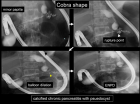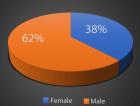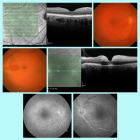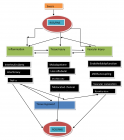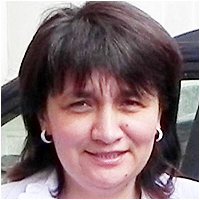Current Issue (Volume - 8 | Issue - 1)
Genital Condyloma in a 2-Year-Old Child Secondary to Circumcision: A Case Report
Published on: 10th January, 2024
Accumulated condylomas are exophytic tumors with a warty and hyperkeratosic surface due to the Human papillomavirus (HPV). Its prevalence in children is difficult to estimate due to limitations in epidemiological data. Its recurrent character is found in 30% of patients. Its management is very complex in children because of skin fragility. Circumcision is an operation consisting of the removal of part of the foreskin. This practice is done either with a simple knife or a pair of non-aseptic scissors which can be a source of contamination including HPV (Condyloma). Traditional circumcision does not seem to be reported in the literature as a mode of contamination. We report a case of genital condyloma in a child 2 years after circumcision. This is a 2-year-old male with no medical history but with a surgical history of circumcision that was brought by his parents in dermatological consultation for papular lesions accumulated on the penis. At the interrogation, we found the notion of recent circumcision performed by a tradithérapeute. The physical examination finds a good general condition. Dermatological examination reveals on the glans of multiple papules, exophitic, with warty and hyperkeratotic surface, of normal skin color. Furthermore, the physical examination of both parents was normal. The diagnosis of accumulated condyloma secondary to probable circumcision was retained before the clinical appearance of the lesions. Two electrocoagulation sessions spaced one month apart under local anesthesia were the treatment with a favorable evolution.
Cost Assessment of Corticosteroid Therapy for Corticosteroid-sensitive Dermatoses in a Resource-limited Country
Published on: 7th February, 2024
Introduction: Corticosteroid therapy is widely used in dermatology for treating various conditions. In France, the cost of corticosteroid treatment varies, and in Mali, a significant prevalence of corticosteroid-treated diseases has been reported. Given the prolonged treatment duration often required, understanding the cost implications in resource-limited settings is crucial.Patients and methods: This descriptive cross-sectional study took place at the dermatology department of the University Hospital Center of Dermatology in Bamako. Data were prospectively collected from patients undergoing corticosteroid therapy over one year. Variables included sociodemographic data, clinical information, and medication costs.Results: During the study period, 24 cases of dermatoses treated with corticosteroids were identified among 125 hospitalized patients, representing a prevalence of 19.2%. Most patients were women (58.3%), with an average age of 37.5 years. Lichen planus (54.2%) and pemphigus (37.5%) were the most common pathologies. Many patients had extensive lesions before treatment, but the majority responded well to corticosteroids.Discussion: Despite study limitations, such as its descriptive nature, it provided valuable insights into the economic evaluation of long-term corticosteroid therapy. The predominance of women, the age distribution, and the prevalence of specific dermatoses were highlighted. The study also revealed the substantial financial burden of corticosteroid treatment, primarily driven by direct costs.Conclusion: The study underscores the financial challenges associated with long-term corticosteroid therapy in dermatology in Mali. The high costs adversely affect patients and their families, especially considering the socioeconomic status of many patients. Moreover, the findings emphasize the importance of comprehensive care strategies and the need for accessible healthcare solutions to address these challenges effectively.
Successful Treatment of Generalized Pustular Psoriasis during Pregnancy by Cyclosporin and Etanercept: Own Experience and Review of Literature
Published on: 27th February, 2024
Psoriasis is a common inflammatory skin disease affecting about 2% of the population. Generalized pustular psoriasis (GPP) is a rare variant of this disease, and it can be life-threatening for a pregnant woman and fetus.Medication during pregnancy can be challenging since many drugs can cause marked adverse effects for a fetus or newborn baby. Because controlled studies are difficult to perform, the knowledge grows slowly, e.g., from case reports. Here we describe a review of past and present treatments for GPP patients with a special reference to pregnancy and our experience on two GPP cases treated with cyclosporin and etanercept during pregnancy with successful outcomes of infants.
Epidemioclinical Profile of Inflammatory Ringworm in Children at the Koulikoro Reference Health Centre (Csref)
Published on: 10th June, 2024
Introduction: Inflammatory or suppurative ringworm is a rare form of dermatophyte damage to the hair scalp. The aim is to describe the epidemioclinical profile of inflammatory ringworm in children at the Koulikoro Reference Health Centre (Csref).Methodology: This was a 12-month descriptive cross-sectional study of all cases of Kerions diagnosed in children at the Koulikoro Csref.Results: Over 12 months, 25 cases were recorded among 1,200 consulting patients, representing a hospital frequency of 2%.Males were 22 and females three, with a sex ratio of 7.33. The mean age was 7 years, ranging from 2 to 13 years.Conclusion: Celse kerions appear to be common in school-age boys, and contact with domestic animals is described in the majority of cases. Further work is needed to describe the fungi responsible and the risk factors.
Non-surgical Treatment of Verrucous Hyperplasia on Amputation Stump: A Case Report and Literature Review
Published on: 20th September, 2024
Verrucous hyperplasia is a wart-like lesion that can develop on amputation stumps, often due to poor-fitting prostheses, venous stasis, friction, and bacterial infections. While surgical excision is sometimes necessary for intractable cases, many instances can be managed non-surgically. We present the case of a 35-year-old male with a slowly growing verrucous plaque on his amputated stump that had caused repeated infections. His prosthesis was loose, allowing the stump to hang loosely inside the socket. After histological confirmation of verrucous hyperplasia, he was advised to change his prosthesis and use compression bandaging. Over 5 months, the lesion resolved without surgery. Early recognition and non-surgical management, including proper prosthetic fit, compression, and hygiene, can often successfully treat verrucous hyperplasia of amputation stumps. This avoids the need for excision in many cases. Patients and clinicians should be aware of this condition and the importance of prosthetic fit and limb care to prevent and treat it.

HSPI: We're glad you're here. Please click "create a new Query" if you are a new visitor to our website and need further information from us.
If you are already a member of our network and need to keep track of any developments regarding a question you have already submitted, click "take me to my Query."






